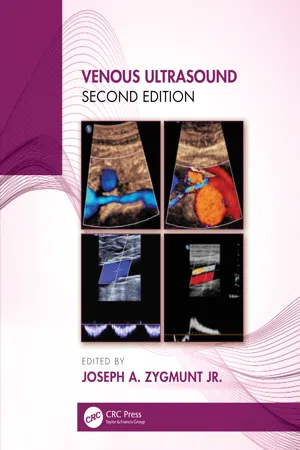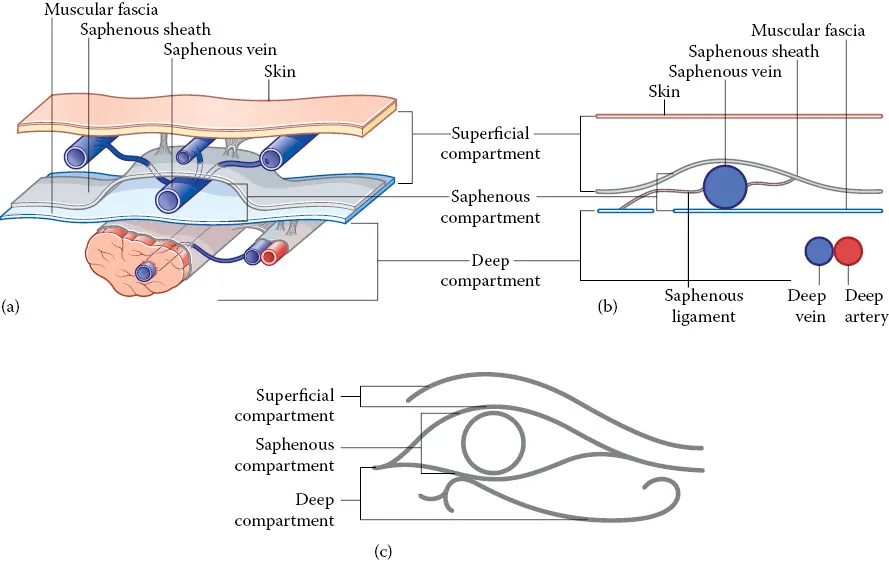
- 229 pages
- English
- ePUB (mobile friendly)
- Available on iOS & Android
Venous Ultrasound
About this book
Venous Ultrasound 2e is the essential text for anyone involved in the treatment of chronic venous disease. It provides specific information on ultrasound as it is applied to chronic insufficiency, including history, general techniques, examples of anatomy, and protocols for performing ultrasound on patients, and discussions on key aspects of interpretation of sonographic findings.
Updated to include the outcome and impact of three recent studies, the ATTRACT trial, the EVRA study, and the VIDIO imaging trial. An entire chapter is dedicated to iliac venous and stent imaging for those interested in expanding practice based on the mentioned studies. Also included is specific protocol for imaging of the pelvic area with focus on the pelvic congestion and reflux affecting this anatomic area. This text demonstrates that as imaging techniques improve, so too will the understanding of venous pathologies increase and the burdens of their respective pathologies. Pelvic Congestion, iliofemoral and late stage disease can be interrogated with a non-invasive approach using the techniques included prior to interventional procedures.
This fully updated new edition includes coverage of new ablation techniques which include non- thermal and non- tumescent therapies for venous insufficiency – these have unique ultrasound properties on what to see, look for and observe in intra and post- operative situations.
Focusing on the fundamentals that every phlebologist needs to know, the color illustrations and numerous line drawings complement the text for a complete learning experience.
Key features:
- Covers anatomy related to venous insufficiency and obstruction
- Protocols with step by step approaches for those new to certain exams
- Includes useful diagrams and images to aid understanding
- Thoroughly up to date, with all the latest information for those practicing venous therapies
Venous Ultrasound 2e is valuable for sonographers and physicians alike; including phlebologists, general and vascular surgeons, physicians, radiologists, angiologists, interventional cardiologist, mid-levels, and nurses who work in this area.
Frequently asked questions
- Essential is ideal for learners and professionals who enjoy exploring a wide range of subjects. Access the Essential Library with 800,000+ trusted titles and best-sellers across business, personal growth, and the humanities. Includes unlimited reading time and Standard Read Aloud voice.
- Complete: Perfect for advanced learners and researchers needing full, unrestricted access. Unlock 1.4M+ books across hundreds of subjects, including academic and specialized titles. The Complete Plan also includes advanced features like Premium Read Aloud and Research Assistant.
Please note we cannot support devices running on iOS 13 and Android 7 or earlier. Learn more about using the app.
Information
| Table 1.1 New nomenclature of key veins | |
| New term | Old term |
| Femoral vein | Superficial femoral vein—eliminated |
| Great saphenous vein (GSV) | Long saphenous vein (LSV)—eliminated |
| Inguinal confluence | Saphenofemoral junction—still used |
| Posterior accessory of the GSV | Posterior arch vein-eliminated Vein of Leonardo-eliminated |
| Small saphenous vein (SSV) | Lesser saphenous vein (LSV)—eliminated |
| Thigh extension of the SSV | Giacomini vein—still used |
| Posterior tibial perforating veins | Cockett vein—decreasing use |

Table of contents
- Cover
- Half Title
- Title Page
- Copyright Page
- First edition dedication
- Second edition dedication
- Contents
- Foreword
- Preface
- Acknowledgments
- Abbreviations
- Editor
- Contributors
- An introduction to colored light
- 1. Venous anatomy
- 2. Indirect noninvasive venous testing
- 3. Principles of Doppler ultrasound
- 4. Ultrasound basics and image optimization
- 5. Practical guide for deep venous patency and obstruction
- 6. Practical guide to scanning the saphenous systems (GSV and SSV) and perforators
- 7. Practical guide for pelvic insufficiency scanning
- 8. Basics of femoral and iliocaval imaging and stent evaluation
- 9. Pre-, intra-, and post-treatment use of duplex ultrasound (thermal and non-thermal)
- 10. Interpretation, documentation and reporting, credentialing, and accreditation
- 11. Sample forms and vein map examples
- Appendix
- Index